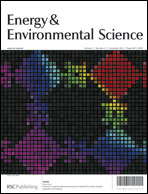Anomalous decrease in structural disorder due to charge redistribution in Cr-doped Li4Ti5O12 negative-electrode materials for high-rate Li-ion batteries†
Abstract
Since one of the main drawbacks of Li4Ti5O12 as a negative-electrode material is its low electronic conductivity, several researchers have attempted to improve the conductivity by narrowing the band gap through transition-metal doping. Herein, we report another, more significant effect of doping in addition to the band gap narrowing, namely, an anomalous decrease in the structural disorder in Li4Ti5O12 upon Cr3+-ion doping. Although it is generally recognized that doping with heterogeneous elements increases the structural disorder, the Cr3+-ion doping in Li4Ti5O12 demonstrated an unexpected structural phenomenon. From the results of various structural analyses using a synchrotron beam, such anomalous structural changes were revealed to originate from charge redistribution at nearby Ti4+ ions. Finally, the capacity was markedly enhanced, especially at high C-rates (125 mA h g−1 for 10C charge/10C discharge, 145 mA h g−1 for 1C charge/50C discharge) because of both the band gap narrowing and the increased ionic diffusivity due to the decreased structural disorder, but was decreased instead for too-high doping levels.


 Please wait while we load your content...
Please wait while we load your content...